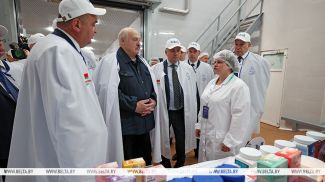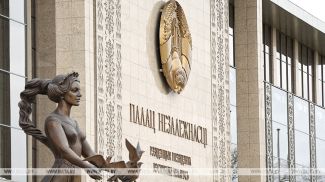Children, drink milk and you will be healthy. You probably remember this funny song from a cute Soviet cartoon. Did you know that Belarus is one of the five top exporters of dairy products? Today Belarusian dairy products can be found on shelves of supermarkets in almost 50 countries across the globe. But it was not always like this. How did the dairy industry develop in Belarus? What Belarusian goods are counterfeited more often than U.S. dollars? Where are the most productive cows in the country? Why did Aleksandr Lukashenko want to raise a monument to a cow? BelTA's YouTube project “After the Fact: Lukashenko's Decisions” has the answers.
Why didn't Belarus allow indiscriminate privatization of agricultural enterprises?
At the beginning of the 2000s about half a tonne of milk per person per year was produced in Belarus. Those were far from the best years for agriculture. And when the going gets tough, what's the most popular advice? Sell state property. Privatization. But Aleksandr Lukashenko thought differently. Yes, the president admitted that, for instance, in Germany private farmers work effectively. They are extremely interested in performance and financial stability. Therefore, agricultural enterprises over there maintain strict labor discipline and technological discipline. Aleksandr Lukashenko wondered why state-run enterprises cannot do the same. He was against a simplified approach to privatization.
“They tell me how good things are in Germany. People over there work from morning till night. Once we start working that hard, we will have plenty of meat and milk!” the president stressed at a seminar for executives of national and municipal government agencies in 2002.
This approach has not changed over the years. Do you remember that in August the head of state said that agriculture needs dictatorship? Aleksandr Lukashenko meant strict labor discipline and technological discipline by that. He pointed out that private farmers treat their own grain differently.
“If something is your own, you treat it differently. They follow the technology. They are in the field all the time. But over here an executive hosts a planning meeting and everyone puffs up cheeks. Dictatorship is needed. And we have one. Let's turn it on. Let's use administrative leverage and make people do things properly. Time to start working really hard,” the president said as he visited the applied science center for arable farming of the National Academy of Sciences of Belarus.
There was another popular belief in the 2000s: large farms did most of the work and fed the nation. Meanwhile, a quarter of agricultural enterprises could barely survive due to various reasons. Proposals were put forward to allocate funding only to those who produce results. Let the rest survive as best as they can. From the point of view of production, Aleksandr Lukashenko said, it would be the right decision. But what about the social factor? If a quarter of the agricultural enterprises are abandoned, or rather, people in the countryside are left to fend for themselves, what will happen? The question is by no means philosophical.
The president proposed to focus on large-scale production enterprises. For example, the head of a district administration saw that a poultry farm or a dairy farm could produce more, but they needed their own feed or an additional raw materials zone. Then decisions were made to attach underperforming farms with the appropriate resources to those that needed more resources. And things seemed to be getting better.
Maria Klimova, Deputy Head of the Central Office for Processing Industry of the Agriculture and Food Ministry, said: “Dairy industry accomplishments owe a lot to the work that began two decades ago. In the early 2000s attention was paid to the overall revival and development of the countryside. In addition to quality parameters, the development of the raw materials base considerable attention was paid to the optimization of enterprises. Small enterprises, which could no longer compete on the world market, were merged with larger and more powerful enterprises. Conditions conducive to optimization and effective processing of raw materials were enabled.
What results did the modernization of Belarus' dairy industry achieve?
Consolidation of enterprises allowed them to be more competitive, raise more investments for the development of resource zones, and increase productivity and work efficiency. In 2001 there were 112 independent organizations in the dairy industry - almost in every district of Belarus. In 2010 there were 57 of them. And today there are 33 organizations like that.
Serious modernization of the Belarusian dairy industry began in 2010. Billions in budget funds were invested in the development of agricultural enterprises. More than 1,500 farms were reconstructed. They keep two thirds of the country's dairy herd of cows. In return today agrarians skim the cream off their labor. In 2010 only every tenth liter of sold milk was of the extra quality grade. Today extra quality milk dominates the market.
Maria Klimova quoted some surprising figures: “FAO experts expect world trade volume to decrease by 3%. Such a decrease has not been witnessed for two decades. Meanwhile, Belarus is busy increasing the output and the export potential. In January-September Belarus increased the export of dairy products by almost 30%. It was nothing less than $570 million.”
Since 2015 milk production in Belarus has increased by 11%, from 7 million to 7.8 million tonnes. It is necessary to increase output up to 9.2 million tonnes by 2025. To put it into perspective, in the same period Russia increased milk production by 8% and makes 222 kilograms of milk per capita per year today. Belarus makes more than 840 kilograms. It is one of the world's best figures. The republic is the absolute leader in the EAEU.
At the same time output figures are declining in the main exporter countries. This year Belarus has already produced about 6 million tonnes of milk. An increase of over 36,000 tonnes in comparison with last year.
“We truly have something to offer. We make over 1,800 dairy product titles. 1,800! We make cheeses, which taste and quality are on par with prominent world brands. A number of Belarusian companies have reached world level results in milk production,” the president remarked at a recent ceremony held to honor the best agribusiness workers.
Here are some more numbers. Belarus makes over 40 butter titles and more than 380 cheese titles. If you want cheese with truffle, you can have some. If you want cheese with fenugreek or with pepper and garlic, there is plenty to go around. Or maybe with a walnut, the aroma of honey or baked milk. Everything is available. Even cheese with blue mold. Truth be told, that kind of cheese is not to everyone's liking.
How many cows does the president's private farm have?
Aleksandr Lukashenko admitted he keeps about ten cows. These are quite ordinary breeds (except possibly for a pedigree cow gifted by the agricultural enterprise Savushkino) but they produce 40-45 liters of milk per day at the age of 11. Keep in mind that 20 liters per day is already a very good figure. All in all, no one has yet managed to hoodwink the Belarusian president with reports about milk yields.
The president's private farm also has goats. Aleksandr Lukashenko admitted they produce magnificent milk. The head of state also keeps bull calves. He is dead set against slaughtering them for meat. Aleksandr Lukashenko mentioned it at a press conference for Russian mass media in late 2018. Moreover, the president stated then that a monument to cows should be erected in Belarus: people survived during the war thanks to this animal. It feeds Belarusians even now.
Interestingly, after a couple of weeks, such a monument was erected outside the main food market of the capital city -- Komarovka. This time it was a coincidence. A competition for the best monument to a cow took place in Minsk back in 2015. But making the monument was slow. Things get done fast when the president sees that animals are cruelly treated or when complete mismanagement is tolerated. Do you remember when in March 2019 dirty cows “unseated” Deputy Prime Minister Mikhail Rusy, Agriculture and Food Minister Leonid Zayats, Mogilev Oblast Governor Vladimir Domanevsky, and Chairman of the Shklov District Executive Committee Vasily Vityunov?
Why are Danish cows being bred in Belarus?
Belarusian scientists are now working on breeding a red Danish cow in the country. These cows are popular in Denmark as well as in Netherlands and Scandinavia. Milk of Danish cows is unique: it has a higher fat content and it contains a very useful AA protein. According to studies of foreign specialists, bodies of children and the elderly can digest such milk more easily.
The scientists plan to start the selection process and make a Belarusian cow breed based on the red Danish one with equal or better qualities and distribute these cows across Belarus. Truth be told, it usually takes 25-30 years to make a new breed. But the Academy of Sciences promises to do it in 10: after all, they are not starting from scratch.
In what countries are Belarusian dairy products sold?
Belarus accounts for 6% of the world trade in dairy products. It is a big figure considering the country is home to 0.12% of the planet's total population and it is ranked 84th in terms of its size. The republic is in one of the world's top 5 exporters of dairy products. The exports are shipped to 48 countries across the globe. At the same time, almost 75-80% of the dairy products made in Belarus are exported. Nearly all of it – 80% – is sold in the Commonwealth of Independent States.
“Asian countries, China have been demonstrating significant growth for the last few years. Mostly powdered milk products are exported to China. But China significantly increased consumption of butter, ice cream, and cheese this year and last year. And this year we have started trading with two new countries in Africa – Niger and Ghana,” said Maria Klimova, Deputy Head of the Central Office for Processing Industry of the Agriculture and Food Ministry.
But it was difficult for Belarusian dairy products to penetrate the European market even before sanctions were introduced. The European Union's high protective duties make imported products uncompetitive in the European market. Therefore, Russia traditionally remains the top destination in the Belarusian export strategy. It is followed by the CIS countries.
Maria Klimova went on saying: “As far as dairy products are concerned, the level of self-dependence in Belarus is 263.3%. It is a significant figure. If we compare it even with Western Europe, their level of self-dependence is 116%. The figure can be as high as 130-170% in Central Europe and Northern Europe. But in Eastern Europe and Southern Europe the figure can be as low as 60-80%.”
Why is Belarusian condensed cream counterfeited?
Condensed milk can rightly be called Belarus' national treasure. For example, the famous Rogachev condensed milk is made according to the principles that have not changed for two centuries. Rogachev Milk Canning Plant is the only enterprise from Kamchatka to the Baltic Sea that practices a continuous condensation technology. The history of the company is amazing. As many as 25 such plants were built in the time of the Soviet Union. Only one remains operational.
Belarusian condensed milk has become so popular that many foreign enterprises have started counterfeiting it. Manufacturers slap on a different label and consumers can no longer distinguish a miserable parody from a unique original product without closely studying all the printed details.
As for cheese production, Belarus is the world's top fourth cheese producer. Belarus could be the third one after the USA and New Zealand, but planetary statistics counts the European Union as one player for some reason. In any case, Belarus is ahead of Australia and Switzerland in gross cheese production. Export earnings exceeded $1 billion last year alone. But Belarus also produces an abundance of processed cheeses, which are not recorded by world statistics.
What companies do Belarusian dairy producers compete with?
We've already mentioned that Belarus focused on setting up large-scale manufacturing facilities. Analysts of the consulting company Streda Consulting note that due to the consolidation of dairy plants the republic has been able to create major players in the post-Soviet space. The total revenue of the top 20 dairy companies in Belarus in 2020 exceeded $3 billion and increased by 22% in ruble terms.
The largest Belarusian producer is the company Savushkin Product. The enterprise with a trade turnover of $742 million per annum took the third place in the Customs Union's top 30 manufacturers list. The first two places in the list were occupied by the world brands Danone Group and Pepsico. Their revenues in the post-Soviet space are 2-2.5 times higher than that of the Brest-based company.
Thanks to the successive absorption of enterprises located in Bereza, Orsha, and Baranovichi, Savushkin Product was able to almost double its revenue in two years. And the ongoing investment projects will allow the company to become one of the largest cheese producers in Eastern Europe in the next few years.
Every year the Belarusian dairy industry beats its own record highs. How can we thank agrarians and producers? How about instituting a milk day? Moreover, it has long been celebrated upon the initiative of the UN. In Argentina, for example, farmers hold a large-scale campaign "A country where milk and honey flow like a river" on this day. In Germany, Milk Day is celebrated under the motto "Faster, stronger, smarter. It's all thanks to milk!". In Norway, the National Dairy Council once held a competition for the best story about milk, the author of which received a cash prize.
The holiday, by the way, was scheduled for 1 June when International Children's Day is also celebrated. That's it. Everything makes sense. Children, drink milk and you will be healthy!













